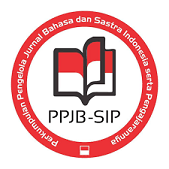PENGGUNAAN MEDIA SHADOW PUPPET UNTUK MENINGKATKAN KETERAMPILAN BERCERITA SISWA KELAS VII B SMP N 2 SERIRIT
DOI:
https://doi.org/10.23887/jjpbs.v7i2.11616Abstract
Penelitian Tindakan Kelas (PTK) ini bertujuan (1) mendeskripsikan langkah-langkah yang ditempuh dalam penggunaan media shadow puppet (2) mendeskripsikan peningkatan kemampuan bercerita dalam pembelajaran berbicara siswa kelas VII B SMP N 2 Seririt dengan menggunakan media shadow puppet (3) mendeskripsikan respons siswa terhadap penggunaan media shadow puppet. Subjek dalam penelitian ini adalah guru dan siswa kelas VII B SMP N 2 Seririt yang berjumlah 30 orang. Objek penelitian ini adalah langkah-langkah pembelajaran,peningkatan hasil belajar, dan respons siswa dalam penggunaan media shadow puppet. Metode pengumpulan data yang digunakan dalam penelitian ini adalah metode observasi, metode tes, dan metode kuesioner. Data dianalisis dengan menggunakan teknik deskriptif kuantitatif dan deskriptif kualitatif. Hasil penelitian menunjukkan bahwa, (1) langkah-langkah pembelajaran yang tepat dalam penelitian ini ditekankan pada penegasan cara berekspresi; (2) penggunaan media shadow puppet dapat meningkatkan kemampuan bercerita dalam pembelajaran berbicara. Pada pratindakan skor rata-rata klasikal 65 (cukup),siklus I memperoleh skor rata-rata klasikal 73,1 (baik), sedangkan pada siklus II nilai rata-rata klasikal siswa menjadi 77,5 (baik); (3) siswa memberikan tanggapan sangat positif terhadap penggunaan media shadow puppet dalam pembelajaran berbicara (bercerita). Oleh karena itu, diharapkan kepada guru Bahasa Indonesia di SMP N 2 Seririt agar menerapkan pembelajaran ini sesuai langkah yang ditemukan dalam penelitian.Kata Kunci : media shadow puppet, berbicara, bercerita
Classroom Action Research (PTK) is aimed (1) describing the steps taken in the use of media shadow puppet media (2) to describe improvement of storytelling skills in learning speaking students’s speaking of class VII B SMP N 2 Seririt by using shadow puppet media (3) to describe the response students against the use of shadow puppet media. Subjects in this study were teachers and students of class VII B and SMP N 2 Seririt totaling 30 people. The object of this research is the steps of learning, improvement of student learning outcomes, and student responses of students in the use of shadow puppet media. Data collection methods used in this research is the method of observation, test methods, and methods of questionnaires. Data were analyzed using descriptive techniques of quantitative and qualitative descriptive. The results showed that, (1) the appropriate learning steps in this study are emphasized on the affirmation of the way of expression; (2) the use of shadow puppet media can enhance the ability of storytelling in learning to speak. In pratindakan average score of classical 65 (enough), the cycle I obtained an average score of 73.1 classical (good), while the second cycle of the average value of classical student becomes 77.5 (good); (3) The students responded very positively to the use of shadow puppet media in learning to talk (storytelling). Therefore, it is expected to Indonesian teacher at SMP N 2 Seririt in order to apply this learning appropriate steps found in the study.
keyword : shadow puppet media, speaking, story telling
Published
2017-07-28
Issue
Section
Articles
License
Authors who publish with the Jurnal Pendidikan Bahasa dan Sastra Indonesia Undiksha agree to the following terms:- Authors retain copyright and grant the journal the right of first publication with the work simultaneously licensed under a Creative Commons Attribution License (CC BY-SA 4.0) that allows others to share the work with an acknowledgment of the work's authorship and initial publication in this journal
- Authors are able to enter into separate, additional contractual arrangements for the non-exclusive distribution of the journal's published version of the work (e.g., post it to an institutional repository or publish it in a book), with an acknowledgment of its initial publication in this journal.
- Authors are permitted and encouraged to post their work online (e.g., in institutional repositories or on their website) prior to and during the submission process, as it can lead to productive exchanges, as well as earlier and greater citation of published work. (See The Effect of Open Access)







